#7: All panels delivered for JUICE's solar wings
16 October 2020
All ten flight model solar panels for ESA's JUICE spacecraft have been delivered to Airbus Defence and Space Netherlands ready to be integrated into solar wings. The solar panels, with a total area of 85 m², are a key element of the mission, providing the necessary power to run the spacecraft and operate the science instruments.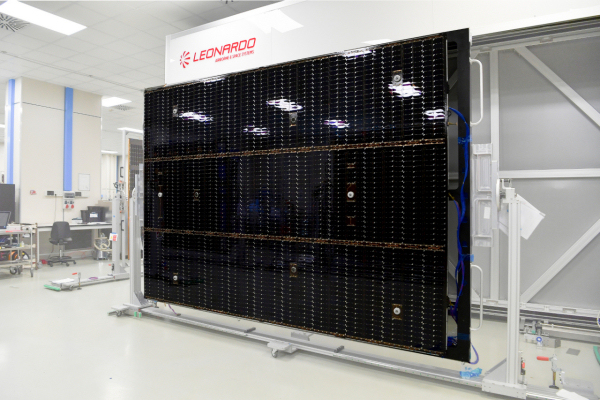 |
| JUICE flight model solar panel. Credit: Leonardo |
JUICE's solar panels are carbon fibre reinforced honeycomb panels, each measuring about 2.5m × 3.5m, on which a grid of 2356 solar cells, or the Photo-Voltaic Array (PVA), is mounted. The spacecraft's two solar wings will each comprise five panels in a distinctive cross shape. These will be folded up to fit inside the launcher, so an elaborate deployment mechanism needs to be foreseen.
Airbus Defence and Space Netherlands in Leiden is responsible for the panel manufacturing and the deployment mechanism. The design, manufacturing and mounting of the PVA required specific skills and was done by Leonardo in Nerviano, near Milan, Italy.
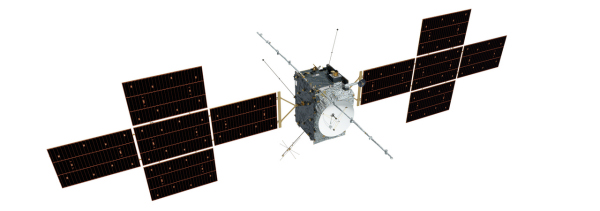 |
| Artist's impression of the JUICE spacecraft. Credit: ESA/ATG medialab |
Environmental testing
The solar array story actually already has a number of chapters in its book. In 2019, a qualification model solar panel was built and subjected to a series of tests, mimicking the extreme environment that the JUICE spacecraft will experience during its mission.
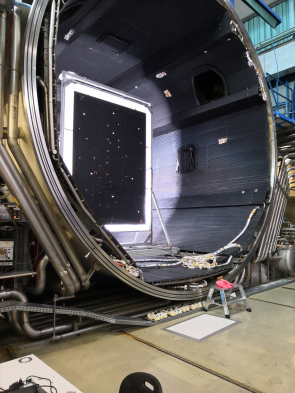 |
| JUICE qualification model solar panel at IABG. Credit: IABG/Leonardo |
The qualification model was the same size of a full flight model panel, but with only a limited number of solar cells on it. Instead, it was equipped with an abundance of other sensors to keep an eye on the performance during testing.
At Industrieanlagen-Betriebsgesellschaft mbH (IABG)'s test facilities in Germany, the full size panel was brought down in temperature to around -150 degrees Celsius, in vacuum, while at the same time being illuminated with an intensity similar to the amount of sunlight at the distance of Jupiter. This way the panel's thermal and electrical properties could be measured to ensure the design is safe and in line with expectations for operating in sun-lit conditions at Jupiter.
In parallel, at several facilities across Europe, components and material samples were tested to ensure that the solar array will also withstand the harsh radiation environment in the Jovian system. Jupiter's massive magnetic field creates a radiation belt around the planet, similar to but stronger than the Van Allen radiation belts around Earth. Unlike electronics units deep inside the spacecraft, which are shielded by dedicated compartments lined with a thin layer of lead, materials and components on the solar array are left unprotected and have to survive the full blast of radiation.
Temperature extremes
JUICE's mission scenario and associated temperature extremes mean additional thermal tests were needed to those done under illuminated conditions at IABG.
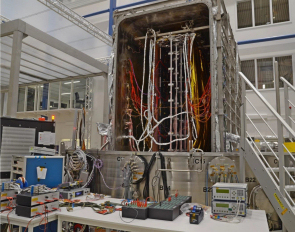 |
| Pair of JUICE flight model solar panels ready for thermal cycling tests. Credit: CSL/Leonardo |
After launch, the spacecraft will rely on a series of gravity assist flybys at Earth (three times), Venus, and Mars, to gain enough speed to eventually reach Jupiter. Near Venus, JUICE will experience more intense solar heating as it orbits closer to the Sun. However, once it is in the Jovian system, about five times further away from the Sun than Earth is, temperatures drop significantly. On top of that, the spacecraft will at times be eclipsed by the giant planet and its moons, deprived from any sunlight, leading to a rapid and extremely deep cool down of the solar arrays. The temperature range the JUICE solar array has to withstand during its entire mission is between +110 degrees Celsius and -230 degrees Celsius.
To test the rapid temperature changes and reach these highest and lowest temperatures on a full sized solar panel required the development of a brand new test facility, called the Wide Range Test Facility (WRTF). This was achieved with the help and experience of Centre Spatial de Liège (CSL) in Belgium. The box shaped WRTF employs a thermal tent and uses liquid helium as the coolant; it is installed within a large vacuum chamber at CSL. The WRTF was first used for testing the qualification model solar panel. Before and after this thermal cycling test the qualification model was tested at IABG under illuminated conditions to detect even minute performance degradations caused by the thermal cycling. Later the WRTF was also used to test each of the ten flight model panels to prove they are flight worthy.
Pairing up
Having overcome all the technical design challenges, there were great logistical challenges to be dealt with too. Indeed, panels packed in garage-box sized containers needed to be shipped all over Europe while at the same time specialists at Leonardo had to figure out how to lay down and mount a total of 23 560 solar cells on ten different panels in reasonable time.
The first bare flight model panels were shipped from the Netherlands to Milan in August 2019 and the lay down of the solar cells began soon after, in September 2019. Manufacturing and testing was done in a staggered approach, per two panels, because the WRTF thermal facility in Belgium can test two panels at the same time. This meant it was possible to mount the solar cells on one set of panels in Italy, while another set could be tested in Belgium at the same time, and have yet another set on the road to the Netherlands again.
Fast forward to 11 September 2020 and all the flight model panels have been delivered back to Airbus Defence and Space in the Netherlands, fully equipped with solar cells and all necessary wiring. This achievement was possible thanks to the hard work of all industrial partners involved and their excellent cooperation, despite the difficulties and restrictions imposed by the Covid-19 pandemic.
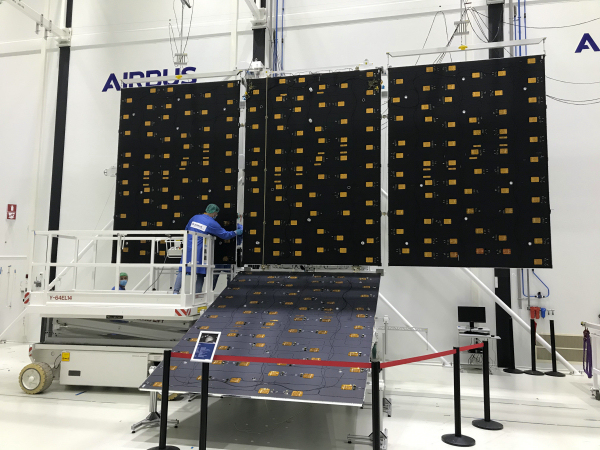 |
| Assembling one of JUICE's solar wings. Credit: Airbus Defence and Space Netherlands |
Solar wing assembly
With all solar panels now under one roof Airbus Defence and Space Netherlands can integrate the individual panels into JUICE's two solar wings. The wings will subsequently be fully tested, mechanically and electrically, before being delivered to Airbus Defence and Space in Toulouse, in the first half of 2021, ready for integration onto the spacecraft.
Once mounted on the spacecraft, further deployment and mechanical tests are needed to verify that all is mounted well and that the spacecraft can receive all of the power generated by the solar array. Having more than 40 m² to deploy on each side of the spacecraft, that will be the next challenge for the engineers and workers that are building and testing the JUICE spacecraft.
About JUICE
JUICE – JUpiter ICy moons Explorer – is the first large-class mission in ESA's Cosmic Vision 2015-2025 programme. It will complete a unique tour of the Jupiter system that will include in-depth studies of three potentially ocean-bearing satellites, Ganymede, Europa and Callisto.
The Jupiter tour includes several flybys of each planet-sized world, culminating with orbit insertion around Ganymede, the largest moon in the Solar System, followed by nine months of operations in its orbit.
JUICE will carry the most powerful scientific payload ever flown to the outer Solar System. It consists of 10 state-of-the-art instruments plus one experiment that uses the spacecraft telecommunication system with ground-based instruments.
JUICE's instruments will enable scientists to compare each of these icy satellites and to investigate the potential for such bodies to harbour habitable environments such as subsurface oceans. They will also carry out observations of Jupiter, its atmosphere, magnetosphere, satellites and rings.




